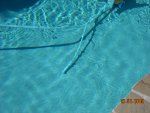Hi guys, I really need some advice...so, let me fill you in on what's been going on with my pool. About 3 weeks ago, we got a lot of rain and my yard overflowed into my pool. I think we got about 10" of rain in 3 days. The night that my pool flooded it started at 10:30 pm and I could see dirt and debris from the yard filtering into the pool. By the time I woke up the next morning, my pool was green, but I could still see the bottom a little. Yuck. I didnt have a good test kit then, but do now. I pumped the excess water off the pool and started to rebalance the pool. The salt level was very low and I had no chlorine. I added salt so the generator could start producing chlorine. I also added a bag of aqua chem plus (sodium dichloro-s-triazinetrione 58%). I used 3 total. (please dont fuss) The pool was clear within two days. I got the leslie's test kit that tests dpd chlorine (did not have powder) and discovered that I had a big difference in free chlorine and total chlorine. A few weeks later I got the supplemental fas dpd test kit (the one that does just that one thing) from yall and I was very surprised to learn that my FC was .5 and my CC was 5.
I dont understand why the CC level is 5 when the water is clear. My other test parameters were okay...ph 7.6, TA 90, CH 250, CYA 40 and salt 3200 water temp is about 59. (12/27/2009)
I've started to shock the pool with bleach. I used the calculator to help me figure out how to get the FC level up to about 20. I think I've added about 8 jugs of bleach over the course 6 hours starting yesterday evening at 4:30 pm. (I checked hourly from 4:30 to 10:30 pm last night and It says 6% and their 96 oz jugs.) And I've also got the SWCG on super chlorinate. FC is 20, CC is 9, ph was very high and I've added 1/2 a gallon to reduce it to 7.5 (I'm out of acid now), TA is 120. I have not tested the CH or CYA today. I'm out of the CYA reagent.
So, I dont understand why the CC level went up and why isn't it falling yet? Any ideas? Thanks for any help.
I dont understand why the CC level is 5 when the water is clear. My other test parameters were okay...ph 7.6, TA 90, CH 250, CYA 40 and salt 3200 water temp is about 59. (12/27/2009)
I've started to shock the pool with bleach. I used the calculator to help me figure out how to get the FC level up to about 20. I think I've added about 8 jugs of bleach over the course 6 hours starting yesterday evening at 4:30 pm. (I checked hourly from 4:30 to 10:30 pm last night and It says 6% and their 96 oz jugs.) And I've also got the SWCG on super chlorinate. FC is 20, CC is 9, ph was very high and I've added 1/2 a gallon to reduce it to 7.5 (I'm out of acid now), TA is 120. I have not tested the CH or CYA today. I'm out of the CYA reagent.
So, I dont understand why the CC level went up and why isn't it falling yet? Any ideas? Thanks for any help.


 ) I've collected enough silt in a couple of years to build a bed in front of the bags, along a 30 ft section, for planting ground cover which will grow over the exposed side of bag too. Another thing to do, if you want a semi-permanent sand bag dyke is to cover the bags with Coolaroo fabric, that blends with your landscaping, and prevents UV breakdown of bags.
) I've collected enough silt in a couple of years to build a bed in front of the bags, along a 30 ft section, for planting ground cover which will grow over the exposed side of bag too. Another thing to do, if you want a semi-permanent sand bag dyke is to cover the bags with Coolaroo fabric, that blends with your landscaping, and prevents UV breakdown of bags.